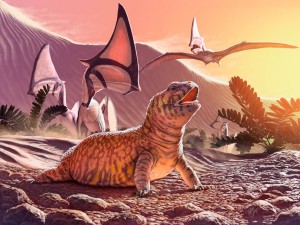When you think about fossils, lizards might be not be one of the first groups that springs to mind. However, they do have a pretty neat fossil record, stretching back over 150 million years. One group of lizards, iguanians, are still around today and comprises about 1700 different species! One sub-group of these iguanians, acrodonts, are thought to have originated in east Gondwana – part of the ‘old world’ including Africa. Acrodonts are named after weird features in their jaws, with teeth fused to the apex of the jaws, as opposed to the inside.
A new fossil reported from Brazil pushes back the time of their origination and shows that acrodonts originated in west Gondwana. The new lizard is reported in Nature Communications (free to read!) and named Gueragama, which in the native Brazilian tongue means ‘ancient lizard’. The little lizard would have been dwarfed in its ecosystem by huge dinosaurs at the time, as well as abundant pterosaurs. The geology of the rocks these animals are found in suggests that it was an ancient oasis. Similar to modern lizards, Gueragama might have burrowed underground to avoid extreme temperatures during the day, and becoming a baked snack for the local predators.
The discovery of this lizard has implications for the evolutionary history of iguanians. Before the supercontinent Pangaea broke up, both acrodont and non-acrodont iguanians had achieved a global distribution. At some point after this, during the Cretaceous period, non-acrodonts ecologically replaced or out-competed acrodonts, and came to dominate North and South America. These days, acrodonts are only known from the ‘Old World’, whereas non-acrodonts are known throughout the ‘New World’, including Madagascar and a few Pacific islands.

Reconstruction of Gueragama alongside some of the local pterosaur faunas. Artwork by Julius Csotonyni.
For more on this story, see this post by Shaena Montanari for Forbes, and coverage by Palaeocast, including comments from the authors.
